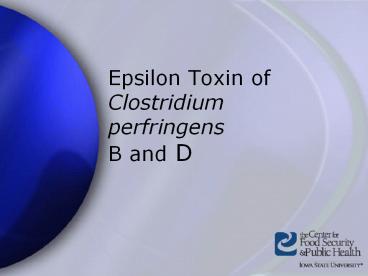Epsilon%20Toxin%20of%20Clostridium%20perfringens%20B%20and%20D - PowerPoint PPT Presentation
Title:
Epsilon%20Toxin%20of%20Clostridium%20perfringens%20B%20and%20D
Description:
Lamb dysentery. Newborn lambs (less than 3 weeks) 95% mortality. Enterotoxemia. Neonatal calves ... not as severe as in lambs ... – PowerPoint PPT presentation
Number of Views:333
Avg rating:3.0/5.0
Title: Epsilon%20Toxin%20of%20Clostridium%20perfringens%20B%20and%20D
1
Epsilon Toxin of Clostridium perfringens B and D
2
Overview
- Organism
- History
- Epidemiology
- Transmission
- Disease in Humans
- Disease in Animals
- Prevention and Control
3
Agent
4
The Agent
- Clostridium perfringens
- Gram-positive bacteria
- Anaerobic rod
- Found in soil, decaying matter and intestinal
tract of mammals - 5 types (A-E)
- Types B and D produce the epsilon toxin
5
Epsilon Toxin
- Produced as an inactive protoxin
- Activated by trypsin
- Removes a 13-residue
N-terminal peptide - Increases intestinal permeability
- Increases vascular permeability
- Vascular damage and edema in brain, heart, lung
and kidneys
6
History
7
History
- Iraq produced 90 gallons of C. perfringens
- 1945 Japan
- Used shrapnel bomb containing C.
perfringens on ten Chinese victims - Slow death from gas gangrene due to infection
from bacteria
8
Transmission
9
Transmission Humans
- Ingestion of C. perfringens A
- Foodborne illness
- Improperly prepared and handled foods
- Aerosolization of C. perfringens A
- Expected to cause high morbidity and mortality
- Consequences of aerosolizing epsilon toxin not
known at this time
10
Transmission Animals
- Normal intestinal inhabitant
- Fecal-oral transmission
- Ingestion of large quantity
- Contaminated soil, water, feed
- Proliferation often caused by disruption of
normal intestinal bacteria
11
Disease in Humans
12
Clostridium perfringens A
- Incubation 8-22 hours
- Intense abdominal pain
- Diarrhea
- Dehydration common side effect
- Most symptoms end by 24 hours
- Very young and very old most severely affected
13
Diagnosis and Treatment
- Diagnosis
- Specific immunoassays available
- Diagnosis of human disease unproven
- No treatment for epsilon toxin
- Penicillin used to treat C. perfringens
- Clindamycin and rifampin
- May suppress epsilon toxin production
- Supportive
- Fluid replacement
- Monitor electrolytes
14
Animals and Epsilon Toxin
15
Animals and Epsilon Toxin
- Rapidly fatal enterotoxemia
- Produces edema
- Edema in brain
- Can induce death and necrosis of brain tissue
16
C. perfringens D
- Cattle and sheep
- Neural manifestations
- Goats
- Diarrhea common
- Mortality
- Highest in lambs
- Calves and goats non fatal subacute and chronic
disease
17
C. perfringens D
- Lamb enterotoxemia
- Overeating disease
- Epsilon toxin
- Systemic toxemia
- CNS lesions, opisthotonus, convulsions, sudden
death - Kidney lesions
- Pulp kidney disease
18
C. perfringens B
- Lamb dysentery
- Newborn lambs (less than 3 weeks)
- 95 mortality
- Enterotoxemia
- Neonatal calves
- Neonatal foals
- Mortality is high but not as severe as in lambs
19
Diagnosis and Treatment
- Diagnosis
- ELISA
- Can detect epsilon toxin with biological fluids
- Intestinal, peritoneal, pericardial
- Toxin-antitoxin neutralization test
- PCR
- Treatment
- Penicillin
- Effective if given early
- Vaccination
- Toxoids
20
Prevention and Control
21
Prevention and Control
- Disinfect with soap and water
- Health care workers
- Should follow standard safety precautions
- Vaccine available for animals
- Follow FDA/USDA guidelines for proper handling of
food
22
Epsilon Toxin as a Biological Weapon
- Toxin can be manufactured by fermentation of C.
perfringens - Chemical synthesis is impractical
- Aerosolization capabilities
- Insufficient information
available at this time - Acute pulmonary illness
23
Acknowledgments
Development of this presentation was funded by a
grant from the Centers for Disease Control and
Prevention to the Center for Food Security and
Public Health at Iowa State University.
24
Acknowledgments
Author Co-author Reviewer
Jamie Snow, DVM, MPH Radford Davis, DVM,
MPH Jean Gladon, BS































